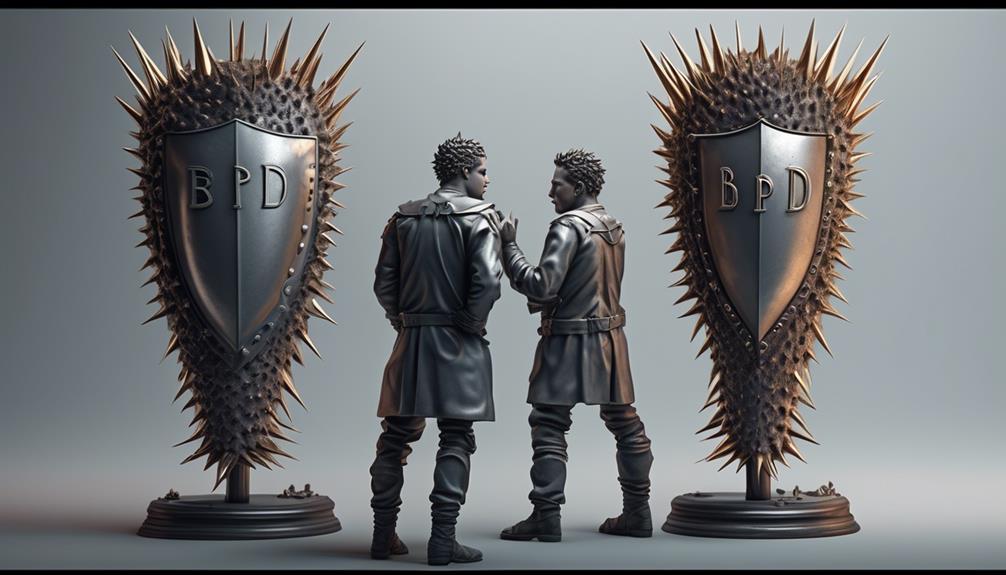Much like a challenging jigsaw puzzle waiting to be put together, age regression in BPD provides a distinct look into the intricate coping strategies used by those with Borderline Personality Disorder.
Understanding how age regression serves as a protective shield in times of distress is just the beginning of unraveling its significance in managing emotions.
As we explore the triggers, manifestations, and treatment approaches related to BPD age regression, a deeper understanding unfolds, shedding light on the intricate ways individuals navigate their inner turmoil.
Key Takeaways
- Age regression in BPD is a coping mechanism for high stress.
- Triggers include fear of abandonment, seeking comfort from toys.
- Professional intervention, therapies like DBT, CBT are crucial.
- Treatment involves tailored strategies, medication, therapy, and support resources.
Understanding BPD Age Regression
What triggers age regression in individuals with Borderline Personality Disorder (BPD)?
Age regression in individuals with BPD is a coping mechanism employed to navigate high-stress adult situations.
This coping mechanism serves as a shield against trauma, stress, and anger, leading to behaviors that may seem childlike or immature.
The anxiety and fear of rejection commonly experienced by individuals with BPD can act as triggers for regression.
During these moments, individuals may retreat to a mental space where they feel safer and protected, often resembling a time from their past when they felt secure.
It isn't uncommon for individuals with BPD to exhibit a mental age that differs significantly from their actual age, struggling with severe age regression at times.
This regression can manifest as behaviors that seem foolish or seeking comfort in a manner reminiscent of a child, all stemming from emotional vulnerability.
Understanding these triggers and manifestations is crucial in providing appropriate support and intervention for individuals with BPD.
Triggers and Manifestations

Triggers for age regression in individuals with Borderline Personality Disorder (BPD) encompass fear of abandonment, relationship conflicts, and intense emotional distress, leading to manifestations such as seeking comfort from toys and displaying childlike temper tantrums. When faced with these triggers, individuals with BPD may exhibit regressive behaviors as a way to cope with overwhelming emotions and stress. Understanding the symptoms of BPD and how they can manifest in regressive behaviors is essential for providing effective support and intervention.
Some key manifestations of age regression in BPD include:
- Seeking comfort from toys: Individuals may revert to using toys or objects associated with childhood to seek solace and security during periods of distress.
- Using baby talk: Communicating in a childlike manner, such as using simplified language or tone, can be a common manifestation of age regression in BPD.
- Displaying childlike temper tantrums: Outbursts of anger or frustration resembling those of a child can occur when individuals with BPD experience overwhelming emotions.
Coping Mechanisms and Implications
When considering coping mechanisms and implications of age regression in individuals with Borderline Personality Disorder (BPD), it's crucial to understand the subconscious nature of this defense mechanism in response to stress and emotional distress. Age regression acts as a coping strategy for managing intense emotions that are challenging to control, especially in the context of personality disorders like BPD. Triggered by events such as heightened fear of abandonment, conflicts in relationships, and overwhelming emotional distress, age regression can manifest as a way to seek comfort and safety in a younger, less threatening state.
Professional intervention from a mental health professional is vital in addressing age regression in individuals with BPD. Therapies such as Dialectical Behavior Therapy (DBT) and Cognitive Behavioral Therapy (CBT) can aid in managing BPD symptoms and reducing instances of age regression. Establishing a supportive and secure environment is essential to assist those experiencing age regression in gradually returning to their adult mindset and effectively managing emotional distress associated with this coping mechanism.
Treatment Approaches for Age Regression

Treatment approaches for age regression involve a comprehensive strategy tailored to address the underlying causes, such as Borderline Personality Disorder (BPD) or Age Regression Disorder (ARD), through a combination of medication, therapy, and support groups. Seeking assistance from a mental health professional is essential in developing an effective treatment plan for individuals experiencing age regression.
- Medication: Psychiatric medications may be prescribed to manage symptoms associated with BPD or ARD, such as anxiety or mood instability.
- Therapy: Psychotherapy, particularly dialectical behavior therapy (DBT) or cognitive-behavioral therapy (CBT), can help individuals understand and cope with triggers that lead to age regression.
- Support Groups: Engaging in support groups specific to BPD or age regression can provide a sense of community, understanding, and shared experiences, fostering emotional support and growth within a supportive environment.
Support Resources for Individuals With BPD
Support resources for individuals with Borderline Personality Disorder (BPD) encompass a range of therapeutic interventions, community-based programs, and online platforms designed to address the unique challenges associated with this mental health disorder. These resources cater to individuals experiencing age regression, a common symptom of BPD, by offering specialized therapy, support groups, and online forums tailored to their needs.
Mental health organizations provide specialized programs and resources aimed at supporting individuals with BPD in seeking help and guidance. Peer support networks and helplines create safe environments for individuals to share experiences, seek advice, and connect with others facing similar struggles. Additionally, online platforms and mobile apps offer tools for managing BPD symptoms, tracking progress, and accessing virtual therapy sessions.
Seeking help from trained professionals such as psychologists, psychiatrists, and counselors is crucial for individuals with BPD to receive personalized support and effective treatment options tailored to their specific needs.
Frequently Asked Questions
Does BPD Get Worse With Age?
Yes, BPD symptoms can worsen with age due to various factors like increased stress, trauma, and life changes.
The severity of symptoms may fluctuate, impacting daily functioning and relationships.
Seeking ongoing support and therapy is crucial for managing BPD symptoms as one ages.
Without proper treatment and management, the disorder can intensify over time, affecting overall well-being.
It's essential to address any worsening symptoms promptly to maintain emotional stability.
What Are Signs of Age Regression?
Age regression signs include behaviors like thumb-sucking, seeking comfort from objects, needing help with tasks, tantrums, and clinginess.
An intriguing statistic reveals that 82% of individuals experiencing age regression report a decrease in stress levels when engaging in childlike behaviors.
This finding underscores the therapeutic aspect of regression for many individuals.
Understanding these signs can aid in recognizing and supporting those exhibiting age regression.
What Is the Life Expectancy of a Person With Borderline Personality Disorder?
We can't provide a specific life expectancy for individuals with Borderline Personality Disorder (BPD) as it varies based on factors like comorbid conditions and access to healthcare. BPD itself doesn't determine life expectancy, but associated behaviors can impact overall health outcomes.
Treatment and therapy can improve quality of life and potentially reduce risks. Comprehensive care and support are crucial for addressing mental health needs and overall well-being in individuals with BPD.
What Is the Borderline Rage Cycle?
When we consider the Borderline Rage Cycle, it's akin to a turbulent storm brewing within individuals with BPD. This cycle encompasses escalating anger, frustration, and emotional dysregulation triggered by perceived rejection or conflict.
The intense outbursts may manifest as verbal or physical aggression, impulsivity, or self-harm. Managing this cycle is crucial in BPD treatment to enhance emotional regulation and curb harmful behaviors.
Conclusion
In conclusion, understanding and addressing BPD age regression is essential for individuals navigating intense emotional distress.
By recognizing triggers, manifestations, and coping mechanisms, individuals can work towards managing this subconscious defense mechanism effectively.
Seeking professional help through therapies like DBT and CBT, along with accessing support resources, can empower individuals with BPD to navigate their emotions in a healthier manner.
Remember, you aren't alone in this journey towards emotional well-being.








